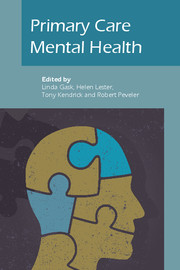Book contents
- Frontmatter
- Contents
- List of figures, tables and boxes
- List of contributors
- Preface
- Part I Conceptual basis and overarching themes
- Part II Clinical issues
- 8 Depression
- 9 Suicide and self-harm
- 10 Anxiety
- 11 Medically unexplained symptoms
- 12 Mental health problems in older people
- 13 Perinatal mental health
- 14 Child and adolescent mental health
- 15 Psychosis
- 16 Emergencies in primary care
- 17 Substance misuse
- 18 Management of alcohol problems
- 19 Eating disorders
- 20 Physical health of people with mental illness
- 21 Ethnic minorities
- 22 Asylum seekers and refugees
- 23 Sexual problems
- Part III Policy and practice
- Part IV Reflective practice
- Epilogue: Racing pigeons and rolling rocks: reflections on complex problems in primary care
- Index
9 - Suicide and self-harm
from Part II - Clinical issues
Published online by Cambridge University Press: 02 January 2018
- Frontmatter
- Contents
- List of figures, tables and boxes
- List of contributors
- Preface
- Part I Conceptual basis and overarching themes
- Part II Clinical issues
- 8 Depression
- 9 Suicide and self-harm
- 10 Anxiety
- 11 Medically unexplained symptoms
- 12 Mental health problems in older people
- 13 Perinatal mental health
- 14 Child and adolescent mental health
- 15 Psychosis
- 16 Emergencies in primary care
- 17 Substance misuse
- 18 Management of alcohol problems
- 19 Eating disorders
- 20 Physical health of people with mental illness
- 21 Ethnic minorities
- 22 Asylum seekers and refugees
- 23 Sexual problems
- Part III Policy and practice
- Part IV Reflective practice
- Epilogue: Racing pigeons and rolling rocks: reflections on complex problems in primary care
- Index
Summary
Terminology and definitions
There has been much discussion about the most suitable terminology for suicidal acts and researchers have tried to find a common terminology and classification as well as operational definitions for the range of suicidal behaviours (O'Carroll et al, 1996; Maris, 2002; De Leo et al, 2004). In this chapter, we use the outcome-based term ‘fatal suicidal acts’ for suicidal behaviour that results in death and ‘non-fatal suicidal acts’ for suicidal actions that do not result in death.
There is no consensus on the definition of fatal suicidal acts, making it difficult, for instance, to collect accurate, comparable total rates of suicide. Numerous definitions are used, the most widely accepted being the definition produced by the World Health Organization (WHO, 2007a): ‘the act of deliberately killing oneself’. Apart from fatal suicidal acts, it is also of great importance to consider non-fatal suicidal acts, because they are one of the strongest predictors of suicide and have significant economic, medical and social costs. Non-fatal suicidal acts are also often called ‘attempted suicide’ (especially in the USA), ‘parasuicide’ and ‘deliberate self-harm’ (especially in Europe), but also ‘non-fatal suicidal behaviour’, ‘non-fatal self-inflicted harm’, ‘self-injury’ and ‘self-directed violence’. The usage of these terms varies considerably between countries.
Epidemiology
Approximately one million people died from fatal suicidal acts in the year 2000, reflecting a ‘global’ mortality rate of 16 per 100 000, or one death every 30 seconds. Suicide is now among the three leading causes of death among those aged 15–45 years (both sexes) and in a growing number of countries the first cause of mortality among men aged 15–34. These figures do not include non-fatal suicidal acts, which are up to 20 times more frequent than fatal suicidal acts (WHO, 2007b). According to WHO estimates, approximately 1.53 million people will die from fatal suicidal acts in 2020, and 10–20 times more people will attempt suicide worldwide. This represents on average one death every 20 seconds and one attempt every 1–2 seconds (WHO, 1999).
- Type
- Chapter
- Information
- Primary Care Mental Health , pp. 125 - 144Publisher: Royal College of PsychiatristsPrint publication year: 2009



